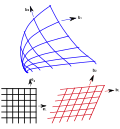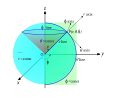Curvilinear coordinates
Curvilinear Coordinates[edit]
Curvilinear coordinates are a system of coordinates used to describe points in space using curves instead of straight lines. Unlike Cartesian coordinates, which use orthogonal axes, curvilinear coordinates utilize curves that are not necessarily perpendicular to each other. This allows for a more flexible and versatile way of representing points in space.
Types of Curvilinear Coordinates[edit]
There are several types of curvilinear coordinate systems, each with its own unique characteristics and applications. Some of the most commonly used curvilinear coordinate systems include:
1. Cylindrical Coordinates: Cylindrical coordinates consist of a radial distance, an azimuthal angle, and a height. They are often used to describe objects with cylindrical symmetry, such as cylinders or rotating objects.
2. Spherical Coordinates: Spherical coordinates consist of a radial distance, an azimuthal angle, and a polar angle. They are particularly useful for describing points on a sphere or objects with spherical symmetry.
3. Ellipsoidal Coordinates: Ellipsoidal coordinates are used to describe points on an ellipsoid, which is a three-dimensional surface resembling a stretched sphere. They consist of three parameters: two angles and a distance from the center of the ellipsoid.
4. Parabolic Coordinates: Parabolic coordinates are a coordinate system that is particularly useful for describing objects with parabolic symmetry, such as parabolic reflectors or antennas. They consist of two parameters: a radial distance and an angle.
Applications[edit]
Curvilinear coordinates find applications in various fields of science and engineering. Some notable applications include:
1. Physics: Curvilinear coordinates are extensively used in physics, especially in the study of electromagnetism, fluid dynamics, and general relativity. They provide a convenient way to describe the behavior of physical systems in curved spaces.
2. Engineering: Curvilinear coordinates are commonly used in engineering disciplines such as structural analysis, heat transfer, and fluid mechanics. They allow engineers to model and analyze complex systems with curved geometries more accurately.
3. Geography: Curvilinear coordinates are used in geographic information systems (GIS) to represent and analyze spatial data. They enable the accurate representation of curved surfaces, such as the Earth's surface, and facilitate various geospatial analyses.
Advantages and Limitations[edit]
Curvilinear coordinates offer several advantages over Cartesian coordinates in certain situations. They provide a more natural representation for objects with curved geometries and can simplify the mathematical description of physical phenomena in curved spaces. Additionally, curvilinear coordinates often lead to simpler equations and more efficient numerical methods for solving problems.
However, curvilinear coordinates also have some limitations. They can be more challenging to work with mathematically, especially when it comes to differentiation and integration. Additionally, the choice of a specific curvilinear coordinate system may depend on the problem at hand, and different coordinate systems may be more suitable for different applications.
Conclusion[edit]
Curvilinear coordinates provide a powerful tool for describing points in space using curves instead of straight lines. They offer a more flexible and versatile way of representing objects with curved geometries and find applications in various scientific and engineering fields. While they have advantages over Cartesian coordinates in certain situations, they also come with their own challenges and limitations. Understanding and utilizing curvilinear coordinates can greatly enhance our ability to model and analyze complex systems in curved spaces.
See Also[edit]
- Cartesian coordinates
- Coordinate system
- Orthogonal coordinates
- Transformation matrix
- Vector calculus
References[edit]
<references group="" responsive="1"></references>
Curvilinear coordinates gallery[edit]
-
Curvilinear
-
General curvilinear coordinates 1
-
Spherical coordinate elements
-
Vector 1-form
-
Local basis transformation
Ad. Transform your life with W8MD's Budget GLP-1 injections from $75


W8MD offers a medical weight loss program to lose weight in Philadelphia. Our physician-supervised medical weight loss provides:
- Weight loss injections in NYC (generic and brand names):
- Zepbound / Mounjaro, Wegovy / Ozempic, Saxenda
- Most insurances accepted or discounted self-pay rates. We will obtain insurance prior authorizations if needed.
- Generic GLP1 weight loss injections from $75 for the starting dose.
- Also offer prescription weight loss medications including Phentermine, Qsymia, Diethylpropion, Contrave etc.
NYC weight loss doctor appointmentsNYC weight loss doctor appointments
Start your NYC weight loss journey today at our NYC medical weight loss and Philadelphia medical weight loss clinics.
- Call 718-946-5500 to lose weight in NYC or for medical weight loss in Philadelphia 215-676-2334.
- Tags:NYC medical weight loss, Philadelphia lose weight Zepbound NYC, Budget GLP1 weight loss injections, Wegovy Philadelphia, Wegovy NYC, Philadelphia medical weight loss, Brookly weight loss and Wegovy NYC
|
WikiMD's Wellness Encyclopedia |
| Let Food Be Thy Medicine Medicine Thy Food - Hippocrates |
Medical Disclaimer: WikiMD is not a substitute for professional medical advice. The information on WikiMD is provided as an information resource only, may be incorrect, outdated or misleading, and is not to be used or relied on for any diagnostic or treatment purposes. Please consult your health care provider before making any healthcare decisions or for guidance about a specific medical condition. WikiMD expressly disclaims responsibility, and shall have no liability, for any damages, loss, injury, or liability whatsoever suffered as a result of your reliance on the information contained in this site. By visiting this site you agree to the foregoing terms and conditions, which may from time to time be changed or supplemented by WikiMD. If you do not agree to the foregoing terms and conditions, you should not enter or use this site. See full disclaimer.
Credits:Most images are courtesy of Wikimedia commons, and templates, categories Wikipedia, licensed under CC BY SA or similar.
Translate this page: - East Asian
中文,
日本,
한국어,
South Asian
हिन्दी,
தமிழ்,
తెలుగు,
Urdu,
ಕನ್ನಡ,
Southeast Asian
Indonesian,
Vietnamese,
Thai,
မြန်မာဘာသာ,
বাংলা
European
español,
Deutsch,
français,
Greek,
português do Brasil,
polski,
română,
русский,
Nederlands,
norsk,
svenska,
suomi,
Italian
Middle Eastern & African
عربى,
Turkish,
Persian,
Hebrew,
Afrikaans,
isiZulu,
Kiswahili,
Other
Bulgarian,
Hungarian,
Czech,
Swedish,
മലയാളം,
मराठी,
ਪੰਜਾਬੀ,
ગુજરાતી,
Portuguese,
Ukrainian




